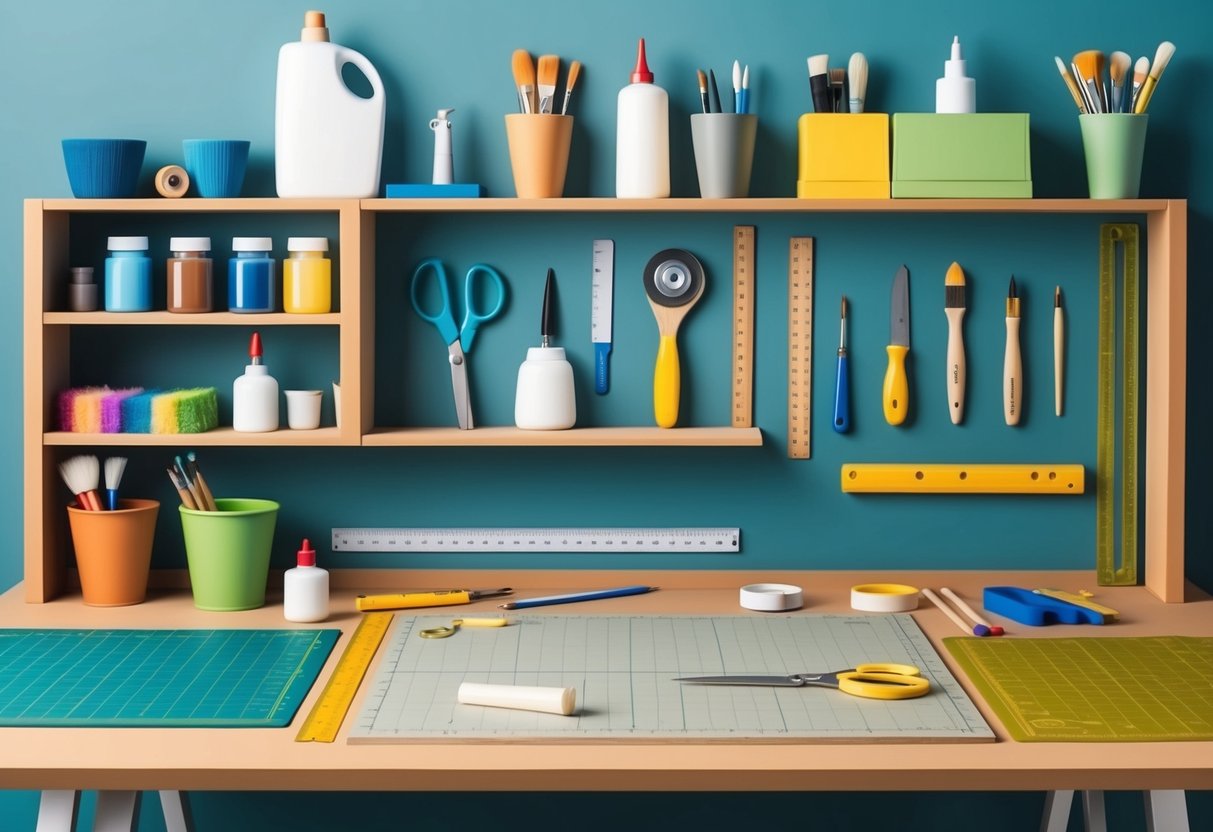
Squares for Precision
Squares are crucial for maintaining precise angles and ensuring project accuracy.
An engineer’s square or a combination square is ideal for marking perfect 90-degree corners on wood, metal, or paper, critical for clean assembly in woodworking and DIY builds.
The speed square is another helpful tool, allowing users to quickly check right angles and mark guide lines for saw cuts.
Sliding bevels and try squares offer flexibility for measuring and replicating various angles.
Consistent use of these tools helps minimize errors and saves time during project assembly.
For hobbyists who demand precise joints and straight edges, investing in a few quality squares is essential.
The difference shows in tight-fitting parts and professional-looking finished projects.
Beginners can refer to lists of recommended squares and measuring tools tailored for woodworking and multi-purpose crafts.
Marking Tools
Effective marking is a key step in turning measurements into action.
Standard pencils are a classic choice for most materials, thanks to their erasability and fine points.
Mechanical pencils can provide even finer lines, making them suitable for detail work or marking on paper.
For marking on wood, carpenter’s pencils with wide, flat leads won’t easily break and stay visible on rougher surfaces.
Fine-tip markers, chalk, and scribing tools are effective for plastic, metal, or darker wood.
It’s important to select a marking tool that suits the specific material and doesn’t smudge or disappear during handling.
Having a set of sharp pencils, colored markers, and a scribe ensures hobbyists are ready for any project, from simple paper crafting to complex woodworking tasks.
Clamping and Holding Tools
Precise clamping and holding tools are indispensable for any hobbyist and are especially vital in model making and miniature projects.
Many DIY crafters find their outcomes improve significantly when using high-quality holding accessories, as these keep delicate workpieces steady for gluing, cutting, and assembly.
Basic Clamps
Basic clamps are used to secure materials together firmly, minimizing slippage during assembly, cutting, or gluing.
There are several types, including C or G clamps, spring clamps, and T-bar clamps, each designed for specific tasks and pressure needs.
C or G clamps are well-suited for heavier-duty holding, while spring clamps are ideal for lightweight, quick jobs.
Hobbyists working with miniatures or converting miniatures often benefit from smaller clamps or bench vices.
They prevent delicate pieces from moving or breaking during precise operations.
Steel clamps provide longevity and maintain a consistent grip pressure over time, essential for repeatable accuracy.
For a more detailed overview of the wide variety and uses of holding tools, visit this guide on clamping tools.
Pin Vises and Detail Holders
Pin vises are crucial for miniature hobby work, particularly when pinning models or drilling small holes for accessories.
These handheld tools provide superior control, allowing hobbyists to drill into fragile plastic, resin, or metal without damaging the piece.
The Tamiya Fine Pin Vise D stands out for its precision and compatibility with ultra-fine drill bits and stainless steel dress pins.
Pin vises excel in detailed repairs, customizing parts, and adding new accessory mounts to models.
They are also invaluable when converting miniatures by creating secure attachment points with pins.
Many hobbyists rely on pin vises for long sessions because these tools reduce hand fatigue and offer steady results.
Proper use of pin vises can enhance the durability and appearance of intricate model assemblies.
Power Tools for Crafting
Power tools give hobbyists a major boost in efficiency and precision.
With the right saws, complex cuts and large projects become much easier to handle and the results are more consistent.
Table Saws and Miter Saws
Table saws are foundational for anyone working with plywood, hardwood, or medium-density fiberboard.
These saws feature a flat surface with a protruding circular saw blade, making them excellent for long, straight cuts.
A high-quality table saw allows users to set blade depth and angle, ensuring smooth, even results with repeatable accuracy.
Safety is essential, so hobbyists should look for models with safety features such as blade guards and emergency shut-offs.
For crafting, saw blades with higher tooth counts create cleaner edges on delicate materials.
Accurate rip fences and miter gauges help users make reliable cuts, even on large or irregular workpieces.
Miter saws excel when angled or crosscuts are needed.
The adjustable fence and blade angle options make them ideal for projects like picture frames, moldings, and trim.
Most modern miter saws offer precise RPM controls and adjustable stops, allowing makers to switch between materials and cut types with ease.
Many hobbyists benefit from choosing a miter saw with ample torque and blade diameter, as these factors increase cutting capacity and ease of use.
Some units also come with built-in dust collection systems, supporting a cleaner workspace and longer tool life.
For a deeper guide to must-have power tools, see this breakdown on starter power tool sets and workshop essentials.
Circular Saws
Circular saws are among the most versatile power tools for crafting. These handheld power tools are particularly useful for breaking down full-size plywood sheets, trimming boards, or making quick plunge cuts.
Their portability makes them a practical choice for both small workshops and large, flexible spaces. Blade selection matters—higher tooth count blades provide cleaner finishes on wood, while specialty blades let users cut plastic, laminate, or even metal.
Adjusting RPM and blade depth gives greater control on different materials, reducing tear-out and increasing safety. Features such as adjustable guides and laser sights can simplify straight-line cutting.
Many circular saws are now cordless, making it easier to work without worrying about cord management while still delivering ample power for demanding hobby tasks. For advice on selecting the best types of saws for your needs, this guide to beginner power tools covers all the basics for setting up your first toolkit.



